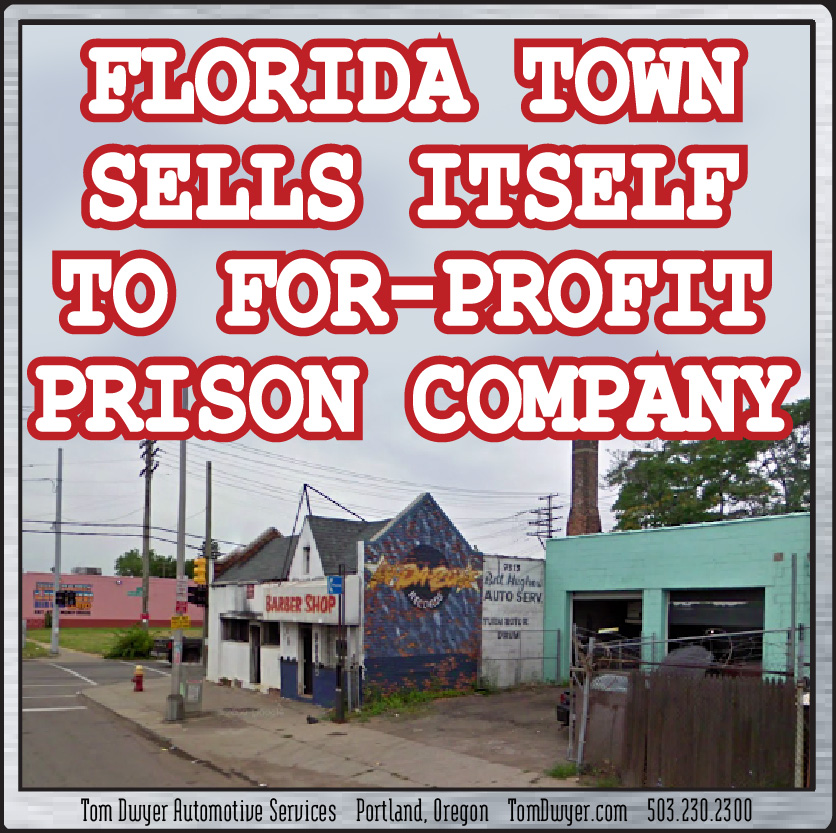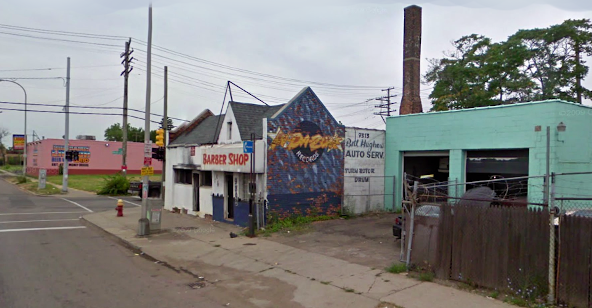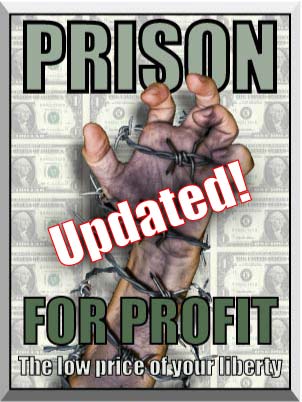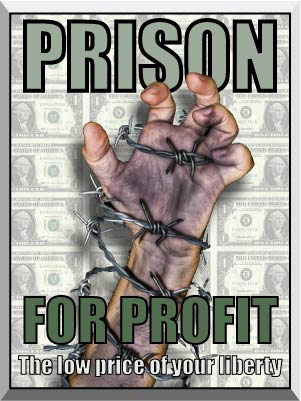 Florida Town sells itself to for-profit prison company
Florida Town sells itself to for-profit prison company
By Charles Letherwood, special report for “Your Car Matters”, April 2019

The main drag of Dubious, Florida
A breeze blows past the derelict barber shop on County Route 17, the last shabby remnant of a once-bustling Main Street in Dubious, Florida. Like much of rural America, Dubious has seen its share of hard times lately with job loss, weather disasters, poverty, and meth and opioid addiction all contributing. For the few remaining young people it’s little more than a waiting room before they escape to the opportunity of nearby big cities like Wewahitchka or Ebro. Dubious, like so many small towns across the country, is dying, but it’s not dying without a fight. The Mayor of Dubious recently forged a coalition to sell the entire town to Profitable Imprisonment Group (PIG), which plans to administer Dubious as the country’s first completely For-Profit Prison Town…

Mayor Daryl Bogus is excited about his new home.
Politicians going to prison rarely have the big smiles of Mayor Daryl Bogus, but then Daryl’s not going to prison. The prison’s coming to him and to the 343 other residents of Dubious, Florida. On Monday, Dubious became the first municipality to turn itself over to a for-profit prison management company, Profitable Imprisonment Group (PIG), becoming the first-ever town run completely as a for-profit prison.We reached Mayor Bogus by phone in his cell, a trailer he once owned but now shares with seven other people. “Three hots and a cot… you can’t beat it!” said Bogus. “And I didn’t even have to commit a crime to get it!” The Mayor explained his inspiration to turn Dubious into the first open-air for-profit prison came from his time living in Wisconsin. “Wisconsin went profit-prison years ago, back when Scott Walker needed donations from CCA to advance in Wisconsin politics. Man, do they have it dialed in! They’re guaranteed a minimum number of prisoners to stay profitable, and they milk those guys at every turn. They’ve got fees for booking, daily room and board, work release, physicals, medication, hospital visits, and dental visits. Even things like this phone call! In Wisconsin they charge $1.80 for a 15-minute call and the state gets a 30% kickback! I thought something like that could be a big profit center for our town. I mean, if a private company could…”

Connor Smarm, PIG
But then Bogus’ phone cut off and the line was picked up by Connor Smarm, VP of Marketing for PIG. “Gosh, I’m sorry about that,” said Smarm. “We try to moderate inmate phone use, especially when they get a little too talkative with the press. I’ll be glad to give you approved answers to any questions about the expansive new freedoms of our pre-criminal municipal economic units.”
What prompted this unique public-private partnership? “It’s something PIG has been looking at for quite a while. While we’re guaranteed a minimum prison occupancy rate to stay profitable, it’s not the maximum profit possible. As a corporation, PIG has a responsibility to its shareholders to maximize profit by any means necessary and we take that very seriously. We work with ALEC, State Legislatures, and lobbyists to design laws that increase sentences. We’ve added fees to every stage of the criminal justice process, including fees for DNA samples, electronic monitoring bracelets, jury fees, public defenders and even room and board. But no matter what we do, some people still escape back into society. Imprisoning an entire town is simply the next logical step to ensure the stable, long-term, income stream our investors deserve.”
Won’t it take a lot of resources to police an entire town? “Not at all”, chuckled Smarm. “We won’t send them to a single prison; they’ll be fitted with ankle bracelets and permitted monitored movement within the city limits. Besides, private prison employees earn an average of over $5,000 less than government-employed counterparts and receive 58 fewer hours of training. Plus, we really aren’t required to have many employees. We don’t need to provide psychiatrists or social workers, and at other prisons we’ve had as few as 2 guards for 800 prisoners. Labor just isn’t a big expense for us at all.”
Smarm hesitated when confronted with the fact that recidivism is higher at private prisons than public ones, but seemed to recover quickly. “Since the people in Dubious will never leave the prison, they’ll never have the opportunity to re-offend. We’ll cut our recidivism rate to 0% in one stroke!”
Still, we were a little disquieted by the idea of mass incarceration solely for corporate profit. When pressed on the unresolvable conflicts of a profit-based justice system, Smarm finally lost patience. “Look, I’m tired of you liberal softies coddling citizens… uh, criminals… uh, pre-criminal-economic-units. I don’t have to tell you anything. We’re a private, for-profit-dammit organization and public records laws don’t apply to us.” After a string of profanities, Smarm finally screamed
“April Fools!”

If you like this article, you may like our past articles on such fun topics as our Robotic Service Advisors, the Oaks Bottom Condos, or How To Check Your Halogen Fluid. If you’re looking for a smile this April Fools Day, start here…
You probably can’t trust much of anything from Connor Smarm, but you can probably trust him that this is an April Fools joke. As far as we know, no towns anywhere have asked a for-profit prison to take them over. Yet. But the issue of For-Profit Prisons is a serious one, the conditions that led to their creation are pervasive, and they’re spreading across the country at a record pace. We usually don’t have a “Digging Deeper” section in our April Fools Features, but for this one we went very deep. If this story caught your attention then you may be very interested in the reality of private, for-profit prisons, and their corrosive effect on our already-shaky justice system…
The Three Corporations That Dominate The Private Prison Industry, Beryl Lipton on MuckRock.com, Jul 2015
CoreCivic (previously Corrections Corporation of America)
Management and Training Corporation (MTC)
Private Prisons Lock Up Thousands Of Americans With Almost No Oversight, Lauren-Brooke Eisen in TIME Magazine, Nov 2017
While there are abuses in public correctional facilities as well, a public prison has very little reason to hide its wrongdoings — no matter how horrible the scandal — because they very rarely lose a contract. The opposite is true for private prisons. In 2010, an Associated Press video revealed that prison guards at Idaho’s largest prison, an Idaho State Correctional Institution operated by CoreCivic, allegedly failed to halt an attack on a prisoner whose head was stomped several times, leaving him permanently disabled. CoreCivic — one of the two largest private prison firms in the nation — lost its contract, and the state of Idaho took control of the prison after a decade and a half of private operation.
Who Profits From Our Prison System? Mapping the corporations and firms with stakes in our jails, prisons, and immigrant-detention centers., Michelle Chen in The Nation, Aug 2018
Even if prisons are run technically in accordance with official regulations, rights groups are wary of intrinsic profit incentives that border on corporate criminality. For example, Tylek explains, prison-industry lobbyists have been known to actively promote the campaigns of anti-immigration hard-liners, as well as harsh anti-marijuana policies—which in turn fuel fresh “demand” for new prison beds and facilities.
“What we even consider a crime,” Tylek says, “is highly shaped by corporate influence…. And the question there becomes, is that how we want crime to be defined, [who decides it] and then who’s targeted by that.” Harsh policing and sentencing standards for drug-related violations, nonviolent property crimes, and other offenses associated with the young and poor have driven mass incarceration since the 1980s. All the while, Wall Street’s white-collar criminals are hardly ever prosecuted—the same kinds of investors who plow money into the prison business, and the same powerful social elite who help drive political discourse that systematically vilifies poor communities, immigrants, and people of color.
Private Prisons in the United States, The Sentencing Project, Aug 2018
Private prisons in the United States incarcerated 128,063 people in 2016, representing 8.5% of the total state and federal prison population. Since 2000, the number of people housed in private prisons has increased 47%.
States show significant variation in their use of private correctional facilities. For example, New Mexico incarcerates over 40% of its prison population in private facilities, while 23 states do not employ any for-profit prisons. Data compiled by the Bureau of Justice Statistics (BJS) and interviews with corrections officials find that in 2016, 27 states and the federal government incarcerated people in private facilities run by corporations including GEO Group, Core Civic (formerly Corrections Corporation of America), and Management and Training Corporation.
According to BJS data, 19 of the states with private prison contracts incarcerate more than 500 people in for-profit prisons. Texas, the first state to adopt private prisons in 1985, incarcerated the largest number of people under state jurisdiction, 13,692.
Since 2000, the number of people in private prisons has increased 47%, compared to an overall rise in the prison population of 9%. In six states, the private prison population has more than doubled during this period. The federal prison system experienced a 120% increase in use of private prisons since 2000, reaching 34,159 people in private facilities in 2016. Among the immigrant detention population, 26,249 people – 73% of the detained population – were confined in privately run facilities in 2017. The private immigrant population grew 442% since 2002.
How Scott Walker Built a Career Sending Wisconsin Inmates to Private Prisons, Scott Keyes in The Nation, Feb 2015
Walker pushed dozens of proposals in the state house to lengthen criminal penalties, for everything from perjury to privacy invasion to intoxicated boating. In just the 1997–98 legislative session, Walker authored or co-sponsored twenty-seven different bills that either expanded the definition of crimes, increased mandatory minimums for offenders, or curbed the possibility of parole.
At the time, Walker openly credited the American Legislative Exchange Council (ALEC) for Truth-in-Sentencing’s success. “Clearly ALEC had proposed model legislation,” Walker told American RadioWorks in 2002. “And probably more important than just the model legislation, [ALEC] had actually put together reports and such that showed the benefits of truth-in-sentencing and showed the successes in other states. And those sorts of statistics were very helpful to us when we pushed it through, when we passed the final legislation.”
Walker conceded that his bills imposing harsher sentences exacerbated the problem. “Criminals will be spending more time in jail, and that means the population will increase as well,” he told the Wauwatosa News-Times. His solution wasn’t to stop imprisoning nonviolent offenders, however, but to put them in private prisons. Walker, like many state legislators during this time, argued that private prisons cost less yet deliver the same quality as their public counterparts.
Decades of research, however, have shown the opposite to be true: across the country, private prisons have been plagued by lax security, falsifying records to cover up understaffing, rampant prisoner mistreatment, and in many cases actually cost taxpayers more money than public prisons. Private prisons also have a clear incentive to increase prison populations—in fact, most private prisons demand a “lockup quota” whereby the state guarantees that most private prison beds will be filled (or would pay for unused beds if crime rates dip). The quota is typically 90 percent, though in some instances can be as high as 100 percent.
Too Good To Be True- Private Prisons in America, Cody Mason at The Sentencing Project, Jan 2012
- Gary Johnson’s platform during his initial 1994 run for governor of New Mexico included a pledge to privatize every prison in the state. By the time he left office in 2003 44.2 percent of the state’s prisoners were in privately run facilities.
- Ohio opened its first private prison in 2000 with the goal of saving $1.6 million per year.16 This raised the number of inmates held privately in Ohio from zero in 1999 to over 3,000 in 2010.
- North Carolina canceled two contracts with CCA due to concerns about the company’s failure to meet contract requirements and banned the practice of bringing in prisoners from out of state. California instituted a similar ban and Arkansas ended two contracts with Wackenhut (GEO) in 2001.
- In 2004 Nevada Governor Kenny Guinn ended CCA’s contract with the state after the company was alleged to have provided substandard services.
- Vermont agreed to start sending prisoners to CCA facilities in Tennessee and Kentucky in 2004. This helped bring the proportion of inmates held privately from zero in 2003 to over 20 percent in 2004. This trend led to Vermont holding over 34 percent of its population privately in 2008, before declining to 27 percent by 2010.
- In 2011 California ended contracts for several GEO Group facilities as part of its Criminal Justice Realignment Plan to reduce prison populations and spending.
- States such as Florida, Ohio, Arizona, New Hampshire, and Utah have been considering beginning or expanding private prison contracting.
The Problem with Private Prisons, Justice Policy Institute, Feb 2018
The corporations running private prisons inevitably claim that they are saving the government money, but their true focus is on protecting their own bottom lines. In order to lower operating costs, these facilities cut corners, hiring fewer employees and paying and training them less. Private prison employees earn an average of over $5,000 less than their government-employed counterparts and receive 58 fewer hours of training. This leads to higher employee turnover and decreased security in the prisons. A 2016 report from the Justice Department found that private prisons had a 28 percent higher rate of inmate-on-inmate assaults and more than twice as many inmate-on-staff assaults, as well as twice as many illicit weapons than comparable federal facilities. The report also found that the Bureau of Prison’s monitors tasked with making sure private prisons comply with federal policy regularly failed to ensure inmates were receiving medical care. One prison went without a full-time doctor for months, a fact that the prison’s monitor failed to report. The lack of adequate security and healthcare unnecessarily endangers the lives of inmates, who are not in a position to do anything about it because they are in prison…
Pay-to-Stay Jail Fees in Wisconsin, Will Maher at the Institute for Research on Poverty, 2017-2018
Being incarcerated can be expensive. Besides the loss of income from work, inmates may be responsible for “pay-to-stay” fees when they are in jail. Pay-to-stay fees are charges assessed to incarcerated individuals and may include fees for booking, daily room and board, work release, physicals, medication, hospital visits, and dental visits. They are distinct from the fines and restitution that defendants maybe ordered to pay as part of their sentences.
Over the last 30 years, the use of pay-to-stay fees has expanded in the United States. The reasons for this are complex but, broadly, are found to be connected to the large growth of the incarcerated population and declines in funding for local justice systems. These fees can place a disproportionate burden on low-income defendants not just because they are less able to pay the fees themselves, but because their lack of financial resources can expose them to longer pretrial jail stays and thus larger fee assessments…
Private Prisons Industry: Increasing Incarcerations, Maximizing Profits and Corrupting Our Democracy, David Donnelly on Huffpost, Dec 2017
- Through involvement in the leadership of ALEC (American Legislative Exchange Council), private prison companies have played a key role in lobbying for and passing harsher sentencing for non-violent offenses including three-strike laws, mandatory sentencing, and truth-in-sentencing. They are also behind the recent spate of anti-immigrant state laws that are putting more and more immigrants behind bars — the new profit center for the prison industrial complex.
- Private prison companies employ legions of lobbyists to push for policies that support their bottom line. Since 2001, three major prison companies, CCA, GEO Group and Cornell, have spent over $22 million lobbying Congress. Recent lobbying by CCA and GEO Group includes efforts to increase funding to Immigration Customs and Enforcement (ICE). Since 2003, CCA has employed 204 of lobbyists in 32 states, and GEO Group has employed by 79 lobbyists in 17 states.
- Private prison companies also influence policymaking by strategically supporting political campaigns. At the federal level, the political action committees and executives of private prison companies have given at least $3.3 million to political parties, candidates, and their political action committees since 2001. The private prison industry has given more than $7.3 million to state candidates and political parties since 2001, including $1.9 million in 2010, the highest amount in the past decade.
Prison Economics Help Drive Arizona Immigration Law, Laura Sullivan on NPR Morning Edition, Oct 2010
Supervision in the Community: Probation and Parole, Michelle Phelps and Caitlin Curry, Oxford Research Encyclopedia, Apr 2017
While much of the scholarly attention has been focused on the development of mass incarceration, new research focuses on the parallel expansion of mass probation and, more broadly, mass supervision. In the United States, the number of adults on probation and parole supervision increased from one million in 1980 to a peak of nearly 5.1 million in 2007, more than double the number of inmates in local, state, and federal jails and prisons. Estimates from Europe in the late 2000s suggest that there were approximately 3.5 million on community sanctions, compared to 2 million incarcerated. Individuals on these sanctions serve out their initial sentences (or remaining time after release from jail or prison) while residing in the community under the supervision of a probation or parole officer.
The Fees that Keep Juvenile Offenders in Financial Chains, SharedJustice.org
In the 1950s American sharecropping hung up a “going out of business” sign, but the business was far from closing. In the 1970s and 80s a model not dissimilar to sharecropping raised its head in the criminal justice system under a new name: legal financial obligations (LFOs). LFOs are fees added to every stage of the criminal justice process: fees for DNA samples, electronic monitoring bracelets, jury fees, public defenders and even room and board.
I remember my first cable bill and the shock I had when realizing that my $59 cable service ended up costing just under $100. The cable company had added an array of fees to the service, fees for cable box rental, processing, installation, and technical support. Fortunately I was in the military and I had some extra money to cover the cost of those fees. LFOs are fees on steroids and they prey on the poor, including juveniles. In Washington State, when Ardell Shaw was convicted and sentenced to 14 years in prison, he owed $1,800 in court fees. Upon his release that had skyrocketed to $21,000–a 1,066 percent increase.
Questions and Answers about Legal Financial Obligations (LFOs), ACLU Washington
Criminal Justice Debt: A Barrier To Reentry, Bannon, Nagrecha, and Diller, Brennan Center for Justice, 2010
Many states are imposing new and often onerous “user fees” on individuals with criminal convictions. Yet far from being easy money, these fees impose severe – and often hidden – costs on communities, taxpayers, and indigent people convicted of crimes. They create new paths to prison for those unable to pay their debts and make it harder to find employment and housing as well to meet child support obligations.
Across the board, we found that states are introducing new user fees, raising the dollar amounts of existing fees, and intensifying the collection offees and other forms of criminal justice debt such as fines and restitution. But in the rush to collect, made all the more intense by the fiscal crises in many states, no one is considering the ways in which the resulting debt can undermine reentry prospects, pave the way back to prison or jail, and result in yet more costs to the public.
Report Says Private Prison Companies Increase Recidivism, Derek Gilna in Prison Legal News, May 2017
In June 2016, In the Public Interest (ITPI), a non-partisan public policy group, published a report titled “How Private Prison Companies Increase Recidivism,” based upon the fact that for-profit prisons rely upon incarceration to generate revenue – thus they have no incentive to provide rehabilitative programs that reduce recidivism. In a country with the highest incarceration rate in the world, this is a recipe for disaster.
According to a study by the U.S. Department of Justice (DOJ), “50% of incarcerated people return to prison within three years of being released.” The ITPI report noted that “Academic research has found that incarcerating people in prisons operated by private companies, which have business models dependent on incarceration, increases the likelihood of those people recidivating.”
The report further said that while governmental agencies, which do need not to generate profit, typically operate prisons with the goals of rehabilitating prisoners and protecting public safety, private prisons are beholden to stockholders who expect to receive a return on their investment.
“Often,” ITPI wrote, “achieving the profit comes at a cost to prisoners, those who work inside the prisons, and the broader public.”
He Worked Undercover in a For-Profit Prison and It Got Ugly, Lewis Beale on Daily Beast, Sep 2018
American Prison describes how slavery helped create enormous wealth in the South, since it was “the most productive system of non-mechanized cotton production the world had ever known.” And even though the 13th Amendment abolished the practice, it left a huge loophole that Southern states took full advantage of. The amendment stated that “neither slavery nor involuntary servitude” were legal, “except as punishment for crime.”
20 Privatization of Prisons Pros and Cons by Crystal Ayres, Vittana Personal Finance Blog
The key benefit of privatizing prisons is that it allows for market forces to govern the expenses that taxpayers must pay to maintain populations. Private companies can often negotiate lower rates for necessary items and save money in many other ways. To unlock this benefit, the for-profit prison must be responsibly managed, with appropriate staffing levels at all times.
The primary disadvantage of prison privatization is that people become commodities. Prisons don’t make money unless they have a prison population to maintain. That means prisoners in for-profit prisons tend to serve longer sentences and have less access to options like probation or early release. A study performed by the University of Wisconsin suggests that prison sentences in a for-profit facility are 7% longer than in public prisons.
Prison Phone Justice Website
This site deals with the issue of prison and jail phone calls, which typically cost much more than non-prison calls. Prison phone contracts are based on a “commission” model, where the phone service provider pays a commission (kickback) to the contracting government agency, such as a state prison system or county jail. These kickbacks inflate the costs of prison and jail phone calls, which in the vast majority of cases are paid not by prisoners but by their family members. This website includes detailed information on state-by-state prison phone rates and commission data, as well as reports, articles and other resources related to prison phone services and the prison phone industry.
Capitalizing on Mass Incarceration: U.S. Growth in Private Prisons, Kara Gotsch and Vinay Basti, The Sentencing Project, Aug 2018
eBay v. Newmark: Al Franken Was Right, Corporations Are Legally Required To Maximize Profits, Max Kennerly in Litigation & Trial, Sep 2010
United States Incarceration Rate, Wikipedia
As Court Fees Rise, The Poor Are Paying The Price, Joseph Shapiro on All Things Considered, May 2014
The Greed Of Private Prisons Is Much Worse Than You Ever Imagined (VIDEO)
And if you want to dig even deeper, we’ve done two articles in our “Your Car Matters” newsletter you’ll find useful…











